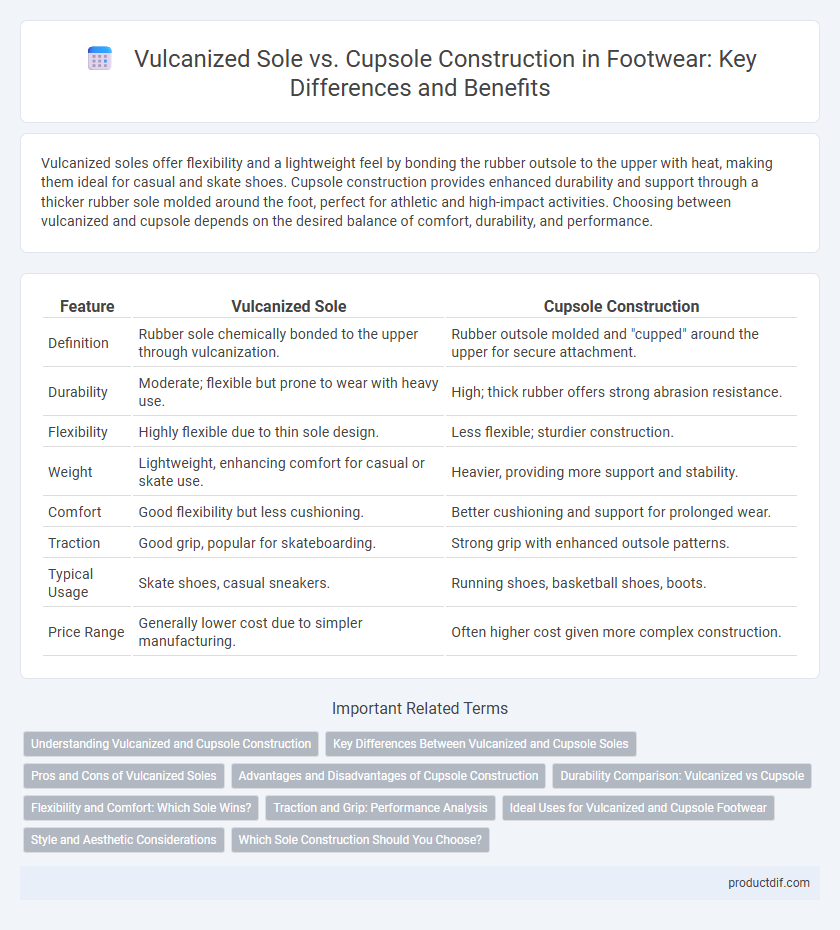Vulcanized soles offer flexibility and a lightweight feel by bonding the rubber outsole to the upper with heat, making them ideal for casual and skate shoes. Cupsole construction provides enhanced durability and support through a thicker rubber sole molded around the foot, perfect for athletic and high-impact activities. Choosing between vulcanized and cupsole depends on the desired balance of comfort, durability, and performance.
Table of Comparison
| Feature | Vulcanized Sole | Cupsole Construction |
|---|---|---|
| Definition | Rubber sole chemically bonded to the upper through vulcanization. | Rubber outsole molded and "cupped" around the upper for secure attachment. |
| Durability | Moderate; flexible but prone to wear with heavy use. | High; thick rubber offers strong abrasion resistance. |
| Flexibility | Highly flexible due to thin sole design. | Less flexible; sturdier construction. |
| Weight | Lightweight, enhancing comfort for casual or skate use. | Heavier, providing more support and stability. |
| Comfort | Good flexibility but less cushioning. | Better cushioning and support for prolonged wear. |
| Traction | Good grip, popular for skateboarding. | Strong grip with enhanced outsole patterns. |
| Typical Usage | Skate shoes, casual sneakers. | Running shoes, basketball shoes, boots. |
| Price Range | Generally lower cost due to simpler manufacturing. | Often higher cost given more complex construction. |
Understanding Vulcanized and Cupsole Construction
Vulcanized soles are made by heating rubber with sulfur, creating a flexible and durable bond that enhances grip and board feel, commonly found in skateboarding shoes. Cupsole construction involves molding a thicker rubber sole around the footbed, providing superior cushioning, support, and impact protection, ideal for high-performance or casual footwear. Understanding these differences helps in selecting shoes based on activities requiring flexibility and board control versus those needing enhanced support and comfort.
Key Differences Between Vulcanized and Cupsole Soles
Vulcanized soles are made by heating rubber to create a flexible, lightweight sole often favored in skateboarding for its superior board feel and durability. Cupsole construction features a thicker, molded rubber sole that provides enhanced cushioning and support, making it ideal for activities requiring more impact protection. The key differences lie in vulcanized soles offering greater flexibility and grip, while cupsoles deliver better shock absorption and structure.
Pros and Cons of Vulcanized Soles
Vulcanized soles offer excellent flexibility and superior board feel, making them popular for skateboarding and casual wear due to their lightweight and thin profile. Their construction provides improved durability against wear but tends to lack the cushioning and arch support found in thicker cupsole designs, which may affect comfort during prolonged use. Vulcanized soles also demonstrate strong resistance to cracking, though they can absorb water more easily, potentially reducing traction in wet conditions.
Advantages and Disadvantages of Cupsole Construction
Cupsole construction offers excellent durability and enhanced support, making it ideal for activities requiring solid foot stability. Its thicker rubber sole provides superior shock absorption but can result in heavier and less flexible footwear compared to vulcanized soles. The manufacturing process allows for more intricate designs and better water resistance, yet cupsole shoes often sacrifice some board feel and flexibility, which may impact performance in activities needing high agility.
Durability Comparison: Vulcanized vs Cupsole
Vulcanized soles feature a heat-treated rubber process, offering flexibility and lightweight comfort but generally less durability under intense wear compared to cupsole construction. Cupsoles consist of a thicker rubber layer molded to the shoe's upper, providing superior resistance to abrasion, impact, and long-term wear. For heavy-duty applications or extended use, cupsole shoes typically outperform vulcanized soles in maintaining structural integrity and longevity.
Flexibility and Comfort: Which Sole Wins?
Vulcanized soles offer superior flexibility due to their thinner rubber layers and direct bonding to the shoe upper, enhancing natural foot movement and providing a lightweight feel. Cupsole construction, while providing better arch support and durability, generally results in a stiffer sole that can limit flexibility and reduce overall comfort during extended wear. For ultimate comfort and flexibility, especially in casual and skate footwear, vulcanized soles typically outperform cupsole designs.
Traction and Grip: Performance Analysis
Vulcanized soles offer superior flexibility and enhanced boardfeel, making them ideal for activities requiring precise foot movements and consistent grip on smooth surfaces. Cupsole construction provides better shock absorption and structural support, improving traction on uneven or rugged terrains through a thicker outsole and defined tread patterns. Performance analysis reveals that vulcanized soles excel in skateboarding and casual wear for agile grip, while cupsoles dominate in hiking and trail footwear where durable traction and stability are critical.
Ideal Uses for Vulcanized and Cupsole Footwear
Vulcanized sole footwear offers flexibility and lighter weight, making it ideal for casual wear, skateboarding, and activities requiring superior board feel and grip. Cupsole construction provides enhanced cushioning, support, and durability, suited for high-impact sports, basketball, and extended daily wear. Choosing between vulcanized and cupsole depends on the need for agility versus stability and impact protection.
Style and Aesthetic Considerations
Vulcanized soles offer a sleek, streamlined silhouette that enhances casual and skate-inspired footwear aesthetics with their thin, flexible design and signature foxing tape. Cupsole construction, featuring a thicker, molded midsole, provides bulkier footwear profiles favored in athletic and retro styles due to their structured appearance and enhanced support. Style preferences often dictate the choice, with vulcanized soles appealing to minimalist and vintage looks while cupsoles cater to bold, performance-oriented designs.
Which Sole Construction Should You Choose?
Vulcanized soles offer superior flexibility and grip, making them ideal for activities that require enhanced board feel and traction, such as skateboarding or casual wear. Cupsole construction provides better support, durability, and impact absorption, preferred in running shoes or sneakers designed for all-day comfort and stability. Choosing between vulcanized and cupsole soles depends on your activity level and comfort needs, with vulcanized soles favoring flexibility and cupsoles excelling in support.
Vulcanized sole vs Cupsole construction Infographic

 productdif.com
productdif.com